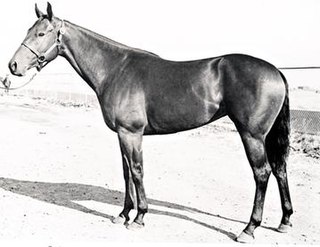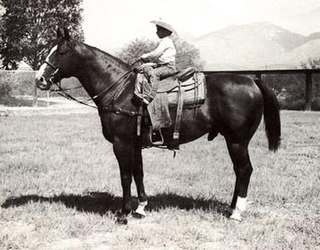Related Research Articles

Easy Jet (1967–1992) was an American Quarter Horse foaled, or born, in 1967, and was one of only two horses to have been a member of the American Quarter Horse Association Hall of Fame as well as being an offspring of members. Easy Jet won the 1969 All American Futurity, the highest race for Quarter Horse racehorses, and was named World Champion Quarter Race Horse in the same year. He earned the highest speed rating awarded at the time—AAAT. After winning 27 of his 38 races in two years of racing, he retired from the race track and became a breeding stallion.
Two Eyed Jack was a Quarter Horse stallion and showhorse, and the leading all time sire of American Quarter Horse Association Champions.
Doc Bar (1956–1992) was a Quarter Horse stallion that was bred to be a racehorse, became an outstanding halter horse, and in his sire career revolutionized the cutting horse industry.

Go Man Go (1953–1983) was an American Quarter Horse stallion and race horse. He was named World Champion Quarter Running Horse three times in a row, one of only two horses to achieve that distinction. Go Man Go was considered to be of difficult temperament. While waiting in the starting gate for his first race, he threw his jockey, broke down the gate, and ran alone around the track; he was eventually caught and went on to win the race. During his five years of competition until his retirement from racing in 1960 he had 27 wins, earning more than $86,000.
Joe Hancock (1926–1943) was an influential Quarter Horse sire in the early years of the American Quarter Horse Association.
Joe Reed II (1936–1964) was a Quarter Horse racehorse from the early days of the American Quarter Horse Association that became an influential sire with the breed.
King (1932–1958), often known as King P-234, was an outstanding early Quarter Horse stallion who influenced the breed throughout the early years of the American Quarter Horse Association.
Leo (1940–1967) was one of the most influential Quarter Horse sires in the early years of the American Quarter Horse Association.
Bert (1934—1956) was one of the most influential sires in the early years of the American Quarter Horse Association (AQHA). He was posthumously inducted into the AQHA Hall of Fame.
Clabber (1936–1947) was a Quarter Horse stallion known as the Iron Horse for his ability to run and win match races after a day of ranch work.
For many years, Oklahoma Star (1915–1943) was known simply as the Tommy Moore Horse, after his breeder, owner, trainer and race jockey. He was an influential Quarter Horse stallion in the early days of the breed.

Peter McCue (1895–1923) was a racehorse and sire influential in the American Quarter Horse Association, although he died before the AQHA was formed.
Old Sorrel, sometimes known as The Old Sorrel, (1915–1945) was a Quarter Horse stallion who was the foundation of the King Ranch linebreeding program for Quarter Horses, and the cornerstone of the King Ranch horse breeding program.
Blondy's Dude (1957–1981) was an influential Quarter Horse show horse and sire. He was posthumously inducted into the AQHA Hall of Fame.
Joe Cody (1952–1989) was a Quarter Horse stallion famous for siring reining horses.
Peppy San (1959–1989), a Quarter Horse stallion, has the distinction of the being the first National Cutting Horse Association World Champion to sire an NCHA World Champion.

Barbara L (1947–1977) was an American Quarter Horse that raced during the early 1950s and often defeated some of the best racehorses of the time. She earned $32,836 on the race track in 81 starts and 21 wins, including six wins in stakes races. She set two track records during her racing career. After retiring from racing in 1955, she went on to become a broodmare and had 14 foals, including 11 who earned their Race Register of Merit with the American Quarter Horse Association (AQHA). Her offspring earned more than $200,000 in race money. She died in 1977 and was inducted into the AQHA's American Quarter Horse Hall of Fame in 2007.
A Quarter Horse stallion, Billy Clegg was a sire during the early years of the American Quarter Horse Association (AQHA).

Garrett's Miss Pawhuska (1946–1975) was a Quarter Horse broodmare who produced eight foals, three of which would become world champion race horses. When she was a yearling, she was sold by her owner, although he had not really planned on selling her. He felt he had to because one of his employees had told a customer the filly was for sale.

Lightning Bar (1951–1960) was an American Quarter Horse who raced and subsequently became a breeding stallion. He was bred by his lifelong owner Art Pollard of Sonoita, Arizona, and was the offspring of Three Bars, a Thoroughbred, and Della P, a Quarter Horse mare from Louisiana, then noted for the breeding of sprint horses. Lightning Bar raced ten times, achieving four victories and four other top three finishes. His racing career was cut short by illness after only one year, following which he spent two years as a show horse. As a breeding stallion he sired seven crops, or years, of foals, among whom Doc Bar was the best known. In 1960 Lightning Bar died of an intestinal infection at the age of nine. He was inducted into the American Quarter Horse Association's (AQHA) Hall of Fame in 2008.
References
- All Breed Pedigree Database Pedigree of Wimpy retrieved on July 17, 2007
- AQHA Hall of Fame accessed on September 2, 2017
- Beckman, Bruce "Number One" Quarter Horse Journal March 1990 p. 36, 147
- Denhardt, Robert "Wimpy P-1 Earned His Number" Quarter Horse Journal June 1964 p. 18, 58, 62, 136-137
- Pitzer, Andrea Laycock The Most Influential Quarter Horse Sires Tacoma, WA:Premier Pedigrees 1987
- Simmons, Diance C. Legends: Outstanding Quarter Horse Stallions and Mares Colorado Springs:Western Horseman 1993 ISBN 0-911647-26-0
- Wohlfarth, Jenny "The Wimpy Files: The Mysteries Surrounding No. 1" Quarter Horse Journal May 1996 p. 18